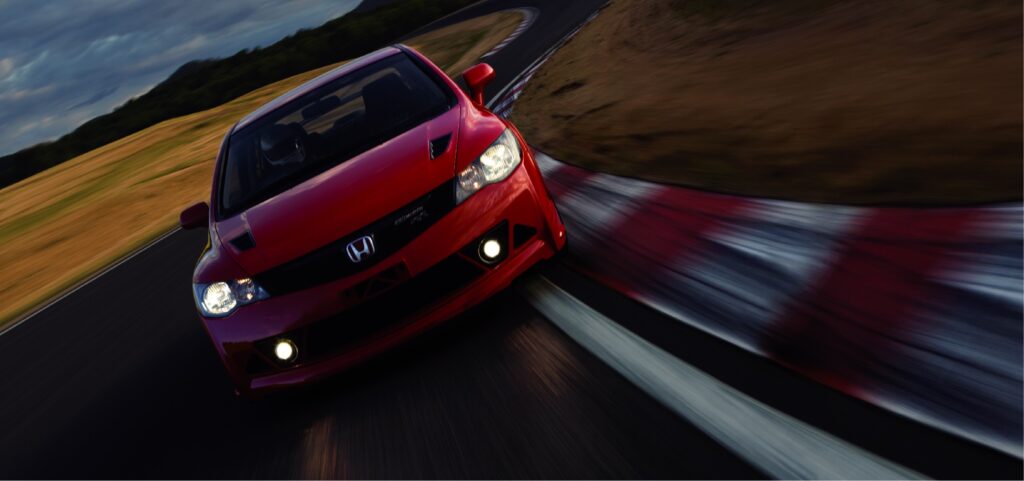

Prologue; The Abortive Attempt of the MUGEN NSX
In 198X, amidst Honda‘s development of the NSX, Mugen secretly began plans to commercialize a special car based on the NSX under the Mugen badge, once it went on sale. Research and preparation started for the enhancement of this super sports car through craftsmanship. This included increasing engine output, specializing the interior and exterior, designing the suspension including the tires, and testing as many tuning options as possible. Among these efforts, the design was overseen by Tatsuya Yura of Mooncraft Co., Ltd. Wind tunnel experiments were utilized extensively, and the use of CFRP parts, which at the time were rare not only in the aftermarket but also in commercial vehicles, was ambitious. In 1992, a test drive event for journalists was held at the JARI (Japan Automobile Research Institute) in Tatebayashi, suggesting that the car was close to being launched. However, the decision was suddenly made not to commercialize it. Since then, the completed car has remained Mugen‘s dream, looking for an opportunity to challenge again.
Opportunity; The Challenge with CIVIC
The 8th generation Civic (FD) was launched in September 2005. The following month, at the Tokyo Motor Show, a “CIVIC HYBRID SPORTS CONCEPT” based on CIVIC HYBRID was quietly exhibited as a surprise in the Honda booth. Although it was strictly a Honda concept car, it was actually built by Mugen. This collaboration later became the catalyst for a joint project with Honda, leading to the creation of a complete car based on the “TYPE R”.
Following the introduction, Mugen set its sights on commercializing a complete car based on the Civic and explored various possibilities. In January 2006, Mugen showcased the CIVIC Dominator concept at the Tokyo Auto Salon Show. The exterior design was a sportier interpretation of the Honda CIVIC HYBRID SPORTS concept as a Mugen concept. The engine was a K20A equipped with a supercharger. In fact, it was confirmed to deliver nearly 300PS in bench tests, and there was a time when the possibility of using a supercharger was being considered. However, due to Honda‘s way at the time, which maintained that the TYPE R should be a naturally aspirated engine, the idea was eventually abandoned.
Honda CIVIC MUGEN RR Development Story; the Road to the Racing
The MUGEN Complete Car Project started in secret. This was not only the first project for MUGEN but also the first collaboration with Honda. The project’s direction and various adjustments were a continuous process of trial and error. The rigor of development and management promotion was expected, but these adjustments proved to be particularly challenging. Below is the development theme excerpted from the press release at the time of the press release.
To assess athletic performance, we chose Tsukuba Circuit (Course 2000) as a practical proving ground. In this challenge, we focused on tuning the suspension system (including specialized tires), improving engine output, reducing vehicle weight, and optimizing aerodynamic form. Especially for the aeroparts design, we optimized the balance between the front and rear to enhance cornering force at Tsukuba, while simultaneously pursuing a negative lift coefficient (CL) and reducing air resistance (Cd). This approach enabled us to achieve moderate downforce (negative lift), extract the grip of the RE070 RR spec tires (with enhanced rigidity), and improve cornering speed. Finding this balance was difficult because it’s akin to a racing car methodology. Consequently, while the performance and times at Tsukuba were very favorable, on circuits with long straights (such as Suzuka or Fuji), there was a trade-off with cornering performance, and it closely matched the normal TYPE R. However, we consider achieving the “Best in Tsukuba” as a big accomplishment. Development was spearheaded by Tetsuya Yamano as the test driver. After finalizing the suspension specs, it was an unexpected result that the ride quality improved over the normal TYPE R, likely due to the increased tire rigidity, which reduced the spring/damper and tire itself’s spring coefficient, enhancing the absorption of road inputs.

Episode1; Defanged MUGEN Si
During the period when Mugen was promoting the planning and development of the Honda CIVIC MUGEN RR in Japan, it was also considering a full entry into the North American market. They successfully seized the opportunity to launch a limited edition vehicle in America based on the MUGEN RR concept. However, unlike in Japan, the selling entity became American Honda Motor Co.,Inc. As a result, due to differences in regulatory requirements as well as the need to meet the same quality standards as mass-produced vehicles, it was not possible to introduce a significant development menu aimed at enhancing driving and power performance, leading to the creation of a special model focused primarily on styling. It was regrettable that, after its release, many users in the United States expressed their disappointment, especially when comparing it to the Japanese MUGEN RR.
Episode2; The Sealed Complete Car
Concurrently with the development of the Honda CIVIC MUGEN RR, planning and development had commenced on the next complete car based on the FIT, provisionally named F154sc. It incorporated a 1.5L engine plus a supercharger, and tests aimed at enhancing power and driving performance had been conducted. Some aspects, including the design of external parts, had also been finalized, and the timing for its introduction was being considered. However, it was shelved and eventually cancelled in the wake of the Lehman Brothers collapse.






